Yeovil Trades & Traders
josiah hannam
Ironmonger of the Borough
Josiah Hannam was born on 24 November 1796 at Gillingham in Dorset and remained a bachelor all his life, until the age of seventy. He was the son of silk throwster Josiah Hannam and his wife Mary, both Quakers, and Josiah Jnr's birth is recorded in the Quaker register of births, shown below.
![]()
The register also records the births of Josiah's siblings; Samuel (1792), Catherine (1793), Mary (1794), Hannah (1798), John (1800), Rachel (1802) and Martha (1804).
During the early part of the nineteenth century Tabernacle Lane was called Hannam's Lane after him because he had an ironmongery shop on the corner and a large ironmongery warehouse halfway down the lane. He was was a senior member of the Society of Friends, a member of Yeovil's Vestry, a burgess of the old Yeovil Corporation and was also one of Yeovil's Improvement Commissioners established by Act of Parliament in 1830 and as such played a key role in the early development of the town. He later became a Trustee of the Yeovil Guardian Friendly Society and, in 1850, he was elected Portreeve of Yeovil.

Josiah Hannam's signature against the Vestry minutes of 26 July 1832.
In 1827 he issued a circular announcing that he had moved his business to the Borough and taken over the ironmongery business "so long held by Mr Edwards" (in today's 15 High Street - see Gallery). William Edwards had been in business in the Borough at least as early as 1771 and built new premises in the Borough in 1790 when he was listed as an ironmonger and cutler in the Universal British Directory.
Hannam's last listing was in Pigot's Directory of 1824 in which he was listed as an ironmonger and manufacturer. This same year of 1827 Hannam was listed on the Jury List as an ironmonger of the Borough. In 1834 he was listed as a subscriber to William Hull’s “History of the Glove Trade”.
In the 27 April 1833 edition of the Poor Man's Guardian, in an article concerning the Yeovil Political Union, it referred to Josiah Hannam as "... an ironmonger, and a stiff-rumped, broad-brimmed, gimblet-eyed Quaker, a sort of non-commissioned officer in the Whiggish squad of the town, was again at his dirty work...". Clearly, Hannam was the arch-enemy of the Yeovil Political Union.
In 1837 Josiah was listed in a House of Commons Private Bill concerning Railway Subscription Projects, as an investor in the 'South Western, or Kingsworthy & West Monkton Railway', subscribing £500 (about £54,000 at today's value using the 'historic opportunity cost' of an investment project).
He took over the lease of the Bradford Abbas mill between 1828 and 1836. Prior to 1828 it was leased by the Thompsons of Nether Compton and run as a flax spinning mill.
He was listed in several trade directories including Pigot's Directory of 1830 and the Somerset Gazette Directory of 1840.
It would appear, however, that Josiah Hannam was running two businesses; that of Yeovil ironmonger but also carrying on his father's business in Gillingham as a silk throwster. (A silk "throwster" receives the silk in skein form, the thread of which consists of a number of silk fibres wound together to make a certain diameter or size, the separate fibre having actually been spun by the worm. The silk-waste spinner receives the silk in quite a different form: merely the raw material, packed in bales of various sizes and weights, the contents being a much-tangled mass of all lengths of fibre mixed with much foreign matter, such as ends of straws, twigs, leaves, worms and chrysalis.) The 1841 census recorded Josiah at the Gillingham Silk Mills, together with a female servant, and giving his occupation as silk throwster. It is easy to imagine that there were two Gillingham-born men named Josiah Hannam (as I originally believed) but it transpires that when the Yeovil ironmonger retired from trade in Yeovil, he returned to the Gillingham Silk Mills and continued in business as a silk throwster.
In any event, by 1843 he had entered partnership with Alfred Gillett and the business was known as Hannam & Gillett from that time (although colloquially it was often referred to as 'Hammer and Gimlet').
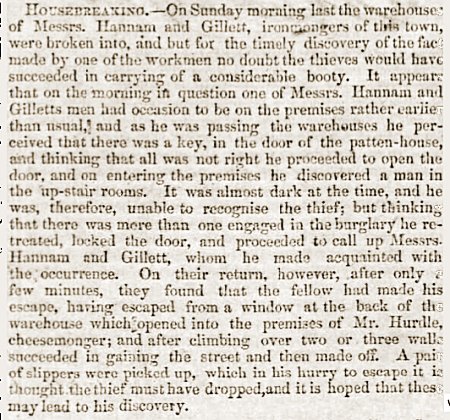
Sherborne
Mercury, 10
December 1842
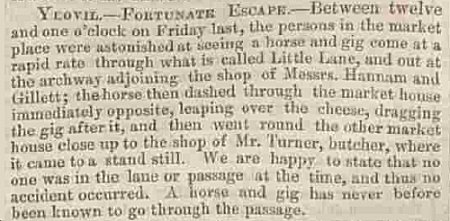
Courtesy of Mike
Taylor
A report from the Bath Chronicle's edition of 5 March 1846 describing how a horse and gig emerged from Tabernacle Lane (then known as Little Lane or Hannam's Lane) into the Borough. - it must have been an impressive and highly unusual sight.
Hannam was noted as the occupier of the Borough premises in 1847 when they were put up for sale by the owner for the sum of £1,200, but there were no bids. Although the owner was not stated at this time, certainly in 1813 the properties either side of Tabernacle Lane were owned by the Yeovil Corporation.
In the 1851 census Hannam gave his occupation as "Ironmonger, firm of 2, employing 13 men". Living with him was his partner in the business Alfred Gillett, three assistants, a housekeeper and a house servant.
In July 1848, having been subpoenaed to serve on the grand jury of the Somerset Quarter Sessions to be held at Wells, he and several other notable Yeovilians were fined £20 each (around £2,000 at today's value) for failing to attend.
In late November 1854, during the Crimean War, the Yeovil Local Patriotic Fund was created as part of the national scheme to support widows and orphans of servicemen killed in action. Support in Yeovil was instantaneous. A list of subscribers was published in the Western Flying Post's edition of 12 December 1854. On first glance it may seem that people were being less than generous until it is realised the £5 in 1854 would be worth around £600 at today's value. The total amount listed was some £427 - in excess of £50,000 at today's value - and all raised in the first week of the appeal. Josiah Hannam subscribed £5 to the fund (around £600 at today's value).
By 1861, still living above his ironmongery shop in the Borough, he gave his occupation in the census as "Ironmonger employing 17 men and 8 Boys". Living with him above the shop were his partner 47-year old ironmonger Alfred Gillett, 22-year old assistant Thomas Denner, another assistant, an ironmonger's apprentice, a housekeeper and a general servant.
Mr Hannam, like all Quakers, never broke his word. A frequently retold story recounted that a young boy ran breathless into the shop to ask if they could please give him "three sixpences for a shilling". Mr Hannam readily consented to oblige. Even when he remembered that the boy had asked for "three" he did not break his word, but warned the youngster not to try it on again.
In April 1862, Josiah Hannam was listed among those subscribing to the new west window in St John's church in memory of Prince Albert. He subscribed £5 (around £550 at today's value).
Hannam & Gillett's business was bought in 1865 by John Petter of Barnstaple, Devon who gave it to his son James Bazeley Petter as a wedding present although the business was advertised as "John Petter, Ironmonger" until at least 1878.
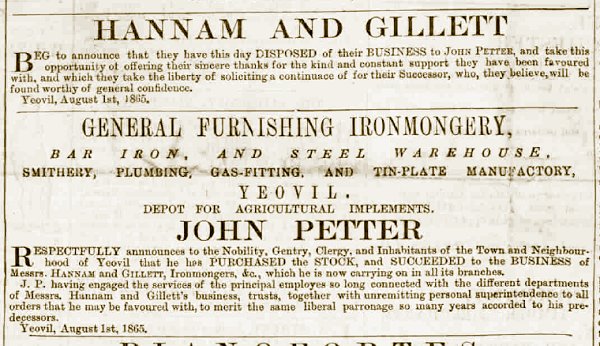
Notice placed in the Western Flying Post's edition of 3 October 1865 (and editions into February 1866) announcing the sale of their business to John Petter, above Petter's notice of purchase. At the same time John Perry, having been the manager of Hanham & Gillett's workshops for some 23 years, set up his own Engineering business in South Street in partnership with his son.
On the sale of his business Josiah Hannam retired from his Yeovil ironmongery business and moved back to Gillingham to run the family silk business.
Surprisingly, at the age of 70, this lifelong bachelor married Jane Hannam Neave at the parish church of Athelhampton, Dorset, on 29 May 1867. She was 22 years his junior and the daughter of Gentleman Edward Neave and his wife Esther. The Neave family were Gillingham Quakers but Jane, born on 30 January 1818, was baptised into the Church of England on 3 June 1848 at the age of thirty - thus presumably accounting for her later marriage to Josiah Hannam in the parish church of Athelhampton.

Courtesy of Mike
Taylor
Marriage certificate of Josiah Hannam and Jane Hannam Neave of 29 May 1867.
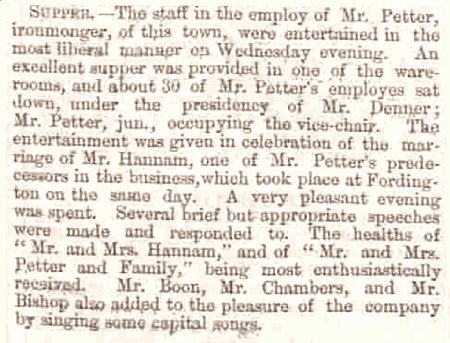
Courtesy of Mike
Taylor
A report from the Sherborne Mercury's edition of 4 June 1867 on a supper.
Josiah Hannam, far from retiring completely, was still the owner of the Gillingham Silk Mills as well as being a major shareholder in the Gillingham Gas Company and other ventures. In the 1871 census Josiah and Jane, together with a servant, were listed living at the Town Mills at Gillingham; he was aged 74, she was 53. Josiah gave his occupation as "Silk Throwster & Miller employing 62 Women & Children 1 Man & 2 Boys".
Josiah Hammond died at Gillingham on 19 November 1874, aged 78. It was rumoured that Josiah's was the last burial to take place in the Friends Burial Ground - see here. However, the last couple of sentences from his obituary, below, disproves that notion. His will was proved at Blandford and his effects were stated to be "under £5,000" (in excess of £3,500,000 at today's value). After Josiah's death Jane moved to Bath, where she died on 8 February 1918.
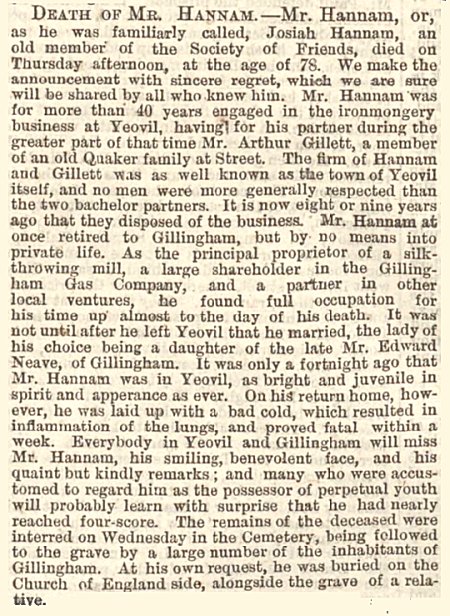
Josiah Hannam's obituary from the Western Gazette's edition of 27 November 1874.
map
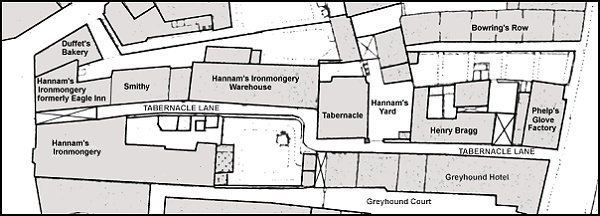
A map (orientated through 90° such that north is at left) based on the 1886 Ordnance Survey showing Tabernacle Lane running between the Borough at left and South Street at right. Josiah Hannam's early ironmongery is seen at left and his large warehouse in Tabernacle Lane left of centre.
gallery
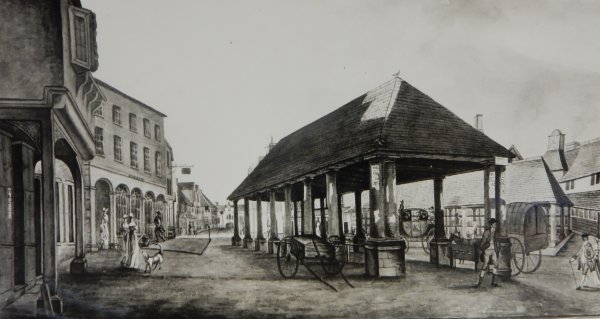
A painting made in 1810 of the Borough looking towards High Street which runs to the distance at left. The building at centre was the Market House, built in 1740, and behind it to the right was the Butchers' Shambles, built in 1803. The Tolle Hall is seen at right, surmounted by its clock or 'horolitch'. At left, the building with the arched ground floor is the only building surviving today in the Borough and originally the ironmongery shop of William Edwards, then Josiah Hannam.
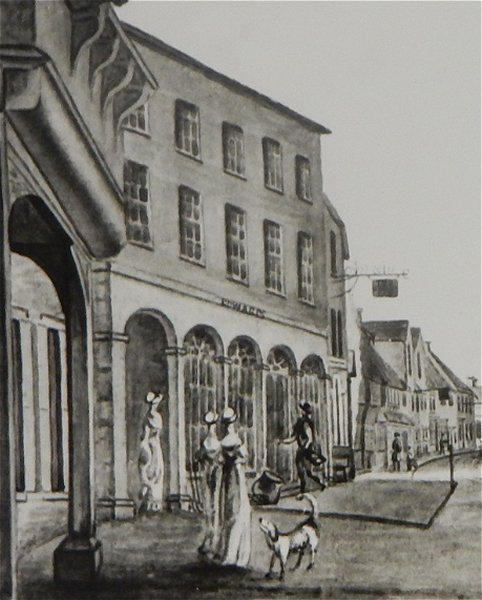
An enlargement of the above painting. At centre, the building with the arched ground floor is the only building surviving in the Borough today and originally the ironmongery shop of William Edwards, whose name appears on the front, then Josiah Hannam. Today it is Superdrug.
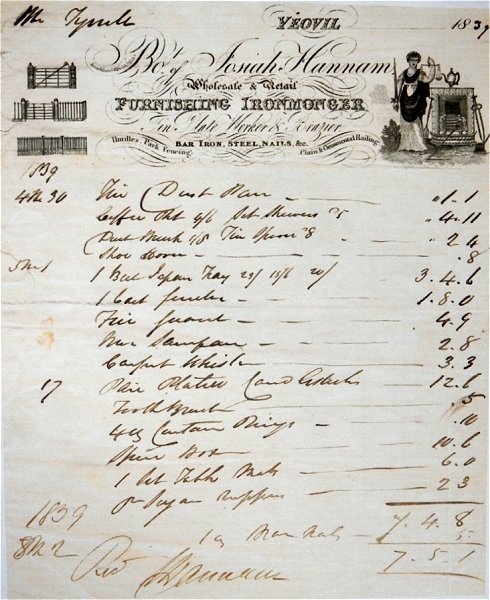
A bill of sale, dated 1839, from Josiah Hannam - including his signature at the bottom.
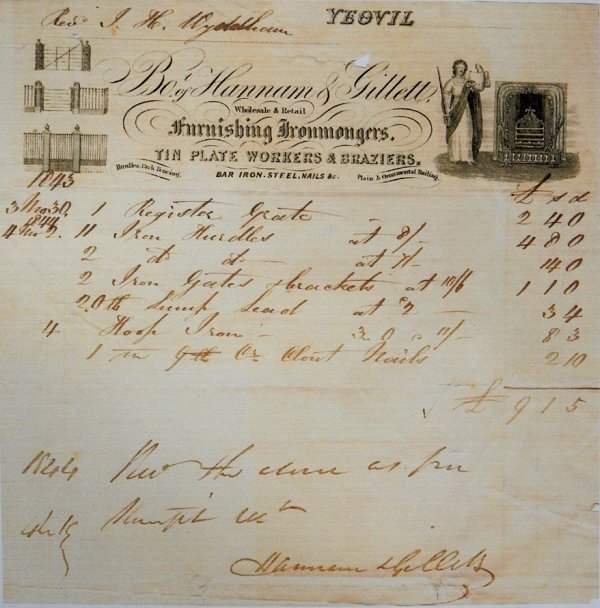
A bill of sale, dated 1843, from Hannam & Gillett.

A horn-handled table knife of about 1845, as sold by Hannam & Gillett, whose mark is stamped into the blade and shown enlarged below.
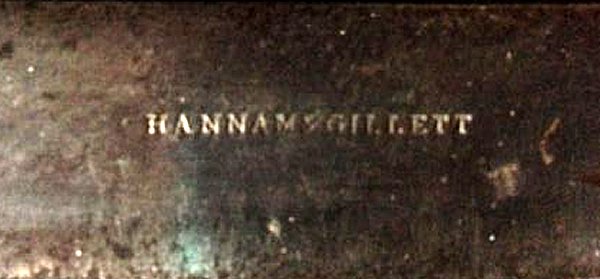
The Hannam & Gillett trade mark stamped into the blade of the above knife.

From my
collection
Spring-loaded wooden finger-stretchers for leather gloves, marked Hannam & Gillett of Yeovil, and therefore dating to the period from 1843 to 1870.
This pair of glove stretchers might have belonged to either a man or a woman. They were used to help ease tight kid gloves so that they would fit over the fingers. They also helped restore the fingers of the gloves after washing, which made them wrinkled and stiff. The user would place the pointed end of the glove stretcher into the finger of a glove and then compress the handle together so that the two ends splayed out, hence stretching the kid leather. During the 19th century the essential mark of a lady was to have small hands and feet and it was partly for this reason that close-fitting gloves were worn. A well-fitting glove was also an important complement to the tailored appearance of men's clothing. Glove stretchers therefore became a vital wardrobe accessory as they assisted the wearer in easing their gloves.
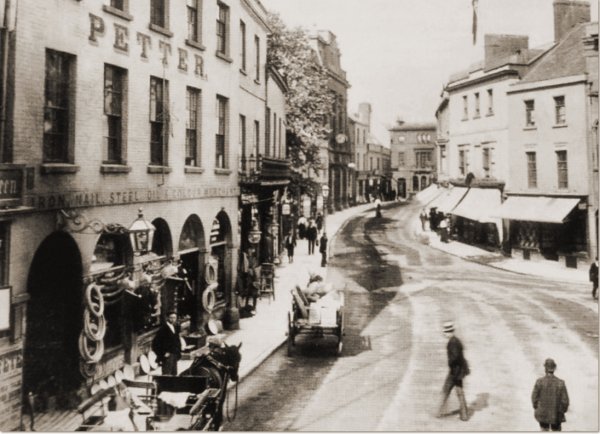
Hannam & Gillett's ironmongery shop in the Borough - by the time of this photograph it was being run by James B Petter.
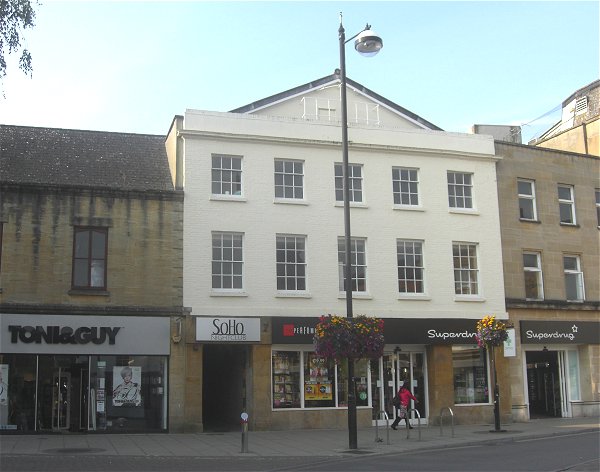
The oldest surviving building in the Borough and originally the ironmongery shop of William Edwards (in 1790), then Josiah Hannam followed by James Bazeley Petter and then Hill & Sawtell. Today it is Superdrug.
Will of Josiah Hannam, 1871
This is the last Will and Testament of me Josiah Hannam of Gillingham in the County of Dorset Silk Throwster. I appoint William Stephens of Bristol Flax Spinner Trustee and Executor of this my Will I devise and bequeath all my real and personal estate whatsoever unto the said William Stephens his heirs executors and administrators according to the nature and quality thereof respectively Upon trust to raise thereout either by Mortgage sale or otherwise howsoever a clear annuity of One hundred and thirty five pounds for my Wife Jane Hannam to be paid to her quarterly the first payment to be made to her at the expiration of three calendar months after my decease and subject thereto I direct that the said William Stephens his heirs executors and administrators shall stand seized and possessed of my said real and personal Estate Upon trust for the said William Stephens and his brothers and sisters Hannam Stephens Frederick Stephens Elizabeth Stephens and Anna Rachel Stephens their heirs executors and administrators respectively in equal share and proportions In witness whereof I have hereto set my hand this day of May One thousand eight hundred and seventy one
Signed by the said Testator as and for his last Will and Testament in the presence of us who at his request in his presence and in the presence of each other have hereunto subscribed our names as witnesses. Josiah Hannam John Slade Sol(icito)r Yeovil Nelson Hawkins, Clerk to Messrs Slade & Son Yeovil
Transcribed by Bob Osborn